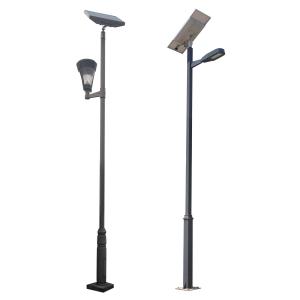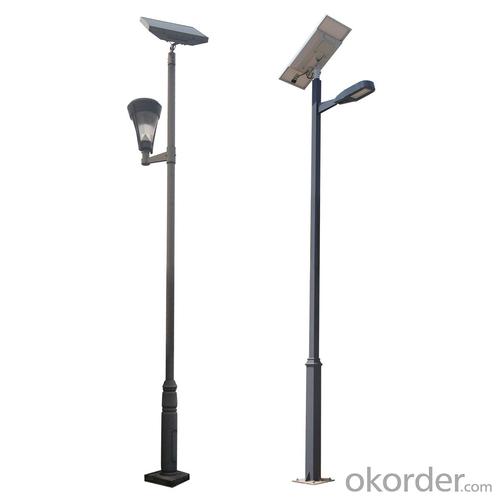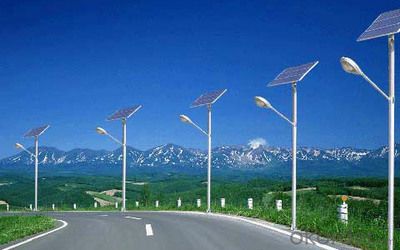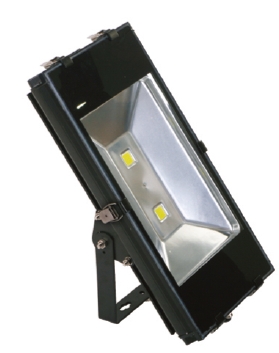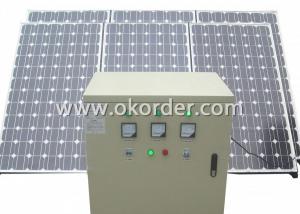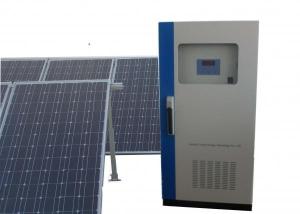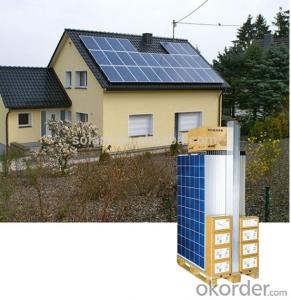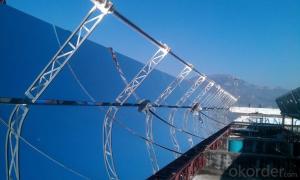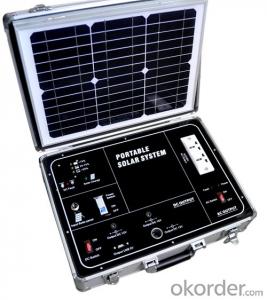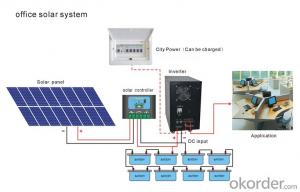Solar Energy Systems Silloth - High Efficiency & New Energy Solar Products
- Loading Port:
- Shanghai
- Payment Terms:
- TT or LC
- Min Order Qty:
- 10 pc
- Supply Capability:
- 5000 pc/month
OKorder Service Pledge
OKorder Financial Service
You Might Also Like
1, Product desciption
Inverter circuits designed to produce a variable output voltage range are often used within motor speed controllers.
The DC power for the inverter section can be derived from a normal AC wall outlet or some other source. Control and feedback circuitry is used to adjust the final output of the inverter section which will ultimately determine the speed of the motor operating under its mechanical load.
Motor speed control needs are numerous and include things like: industrial motor driven equipment, electric vehicles, rail transport systems, and power tools. (See related: variable-frequency drive ) Switching states are developed for positive, negative and zero voltages as per the patterns given in the switching Table.
The generated gate pulses are given to each switch in accordance with the developed pattern and thus the output is obtained.
Solar power is energy from the sun. "Solar" is the Latin word for "sun" and
And Powerful source of energy. Without it, there will be no life.
Solar energy is considered as a serious source of energy for many years
of the vast amounts of energy that is made freely available, if harnessed by modern technology.
A magnifying glass can be used to heat up a small amount of water.
The short piece of copper tube is sealed at one end and filled with water.
And magnifying glass is then used to warm up the pipe.
Using more than one magnifying glass will increase the temperature more rapidly.
2, Features of the product
Inverters convert low frequency main AC power to higher frequency for use in induction heating.
To do this, AC power is first rectified to provide DC power. The inverter then changes the DC power to high frequency AC power. Due to the reduction in the number of DC Sources employed, the structure becomes more reliable and the output voltage has higher resolution due to an increase in the number of steps so that the reference sinusoidal voltage can be better achieved.
This configuration has recently become very popular in AC power supply and adjustable speed drive applications. This new inverter can avoid extra clamping diodes or voltage balancing capacitors. There are three kinds of level shifted modulation techniques, namely: 1,High and stable conversion efficienly based on over 4 years professional experience
2 ,High reliability with guaranteed +/-10% output power tolerance
3,Proven materials,tempered front glass,and a sturdy anodized aluminum frame allow modules to operate reliably in multiple mountily configurations
4,Combination of high efficicncy and attractive appearance
The first thing to figure out is the length of road in need of street lights.
This can be a small entrance road only a couple hundred of feet long to miles of streets through an area. Does the area currently have any type of lighting available.
What is the reason for needing street lights in this area
Is the electrical grid already nearby or would you need to call in the power company to bring in electrical lines.
If the electric needs to be brought to the area, how much is this going to cost? Depending on how far the grid electric is from the location of the needed lighting, this can be quite expensive.
How much lighting is needed on the street? Do the lights need to be dark sky compliant.
Do the street lights need to run from dusk to dawn or for only a specified number of hours at night.
Are the street lights able to dim in the middle of the night and still provide enough lighting.
These questions need to be answered before you can decide on how many lights you will need to complete the project.
3, Detailed Specification
| ||||||||||||||||||||||||||||||||||||||||||||||||
4, Product Image

- Q: What is the role of solar energy systems in promoting energy independence?
- Solar energy systems play a crucial role in promoting energy independence by providing a clean and renewable source of power. These systems harness the abundant sunlight and convert it into electricity, reducing dependency on fossil fuels and foreign energy sources. By generating electricity locally, solar energy systems empower individuals, businesses, and communities to produce their own energy, reducing reliance on centralized power grids. This decentralization of energy production enhances resilience, reduces transmission losses, and provides a more sustainable and self-sufficient energy future.
- Q: How do solar energy systems impact social equity?
- Solar energy systems can have a positive impact on social equity by providing access to clean and affordable energy for all. By reducing reliance on fossil fuels, solar energy helps to mitigate climate change, which disproportionately affects marginalized communities. Additionally, solar power can create job opportunities and stimulate local economies, promoting social and economic development.
- Q: Are there any risks of electrical short circuits with solar energy systems?
- Yes, there are risks of electrical short circuits with solar energy systems. Just like any other electrical system, solar energy systems can be susceptible to short circuits. A short circuit occurs when there is an unintended path of low resistance that allows a large amount of current to flow. This can happen due to various reasons such as faulty wiring, damaged components, or improper installation. Short circuits can result in overheating, electrical fires, or damage to the system. The high current flow generated by a short circuit can cause wires to melt, insulation to burn, and can even damage the solar panels themselves. In extreme cases, short circuits can lead to explosions or other serious safety hazards. To mitigate the risks of short circuits, it is crucial to ensure proper installation by qualified professionals who follow safety guidelines and adhere to local electrical codes. Regular maintenance and inspection of the system are also important to identify and address any potential issues. It is recommended to have a circuit breaker or fuse installed within the system to automatically disconnect the circuit in case of a short circuit. Additionally, the use of high-quality components and wiring that are specifically designed for solar energy systems can help minimize the risks of short circuits. It is also important to follow manufacturer's instructions and guidelines for system maintenance and operation. Overall, while the risks of electrical short circuits with solar energy systems exist, they can be effectively managed and minimized through proper installation, regular maintenance, and adherence to safety guidelines.
- Q: What are the benefits of installing a solar energy system?
- Installing a solar energy system comes with numerous benefits that make it a compelling choice for individuals, businesses, and communities. First and foremost, solar energy is a renewable and sustainable source of power. Unlike fossil fuels, which are finite and contribute to environmental degradation, solar energy harnesses the power of the sun, which will continue to shine for billions of years. One of the key advantages of solar energy is its ability to reduce electricity bills. By generating your own electricity, you can significantly lower or even eliminate your reliance on grid power, resulting in substantial savings over time. Moreover, solar panels have a long lifespan, typically lasting 25 to 30 years, meaning you can enjoy these cost savings for decades. Not only does solar energy save money, but it also provides a stable and predictable energy cost. As utility prices fluctuate due to various factors, solar energy allows you to lock in your electricity costs and protect yourself from future price increases. This stability can be particularly beneficial for businesses and organizations that need to manage their budgets effectively. Installing a solar energy system also helps to reduce carbon emissions and combat climate change. Solar power is a clean and green energy source that produces no greenhouse gases or air pollutants during operation. By transitioning to solar energy, you can decrease your carbon footprint and contribute to a cleaner and healthier environment for future generations. Furthermore, solar energy systems require minimal maintenance. Once installed, solar panels generally require only occasional cleaning and inspections, making them a hassle-free and low-maintenance energy solution. They also provide energy independence, allowing you to generate your own power and become less reliant on external energy sources. In addition to these benefits, installing solar energy systems can also lead to job creation and economic growth. The solar industry has been rapidly expanding, creating new employment opportunities and contributing to local economies. Investing in solar energy not only benefits the environment but also stimulates economic development and supports the growth of a sustainable and resilient energy sector. Overall, the benefits of installing a solar energy system are vast and multi-faceted. From cost savings and energy independence to environmental sustainability and job creation, solar power offers a compelling solution for a brighter and more sustainable future.
- Q: Can solar energy systems be used in areas with limited access to the electrical grid?
- Yes, solar energy systems can definitely be used in areas with limited access to the electrical grid. In fact, solar power is an ideal solution for such areas as it offers a decentralized and sustainable source of electricity. Solar energy systems, such as photovoltaic panels, harness the energy from the sun and convert it into usable electricity. These systems can be installed in remote locations without the need for extensive electrical infrastructure. By utilizing solar energy systems, areas with limited access to the electrical grid can become self-sufficient in meeting their energy needs. These systems can power essential appliances, such as lighting, communication devices, and small-scale machinery, providing reliable energy even in areas where traditional grid connections are not available or unreliable. Moreover, solar energy systems can bring numerous benefits to areas with limited grid access. They offer an environmentally friendly alternative to traditional fossil fuel-dependent energy sources, thereby reducing carbon emissions and combating climate change. Solar power systems also provide a reliable and consistent source of energy, reducing the dependence on diesel generators or other costly and polluting forms of energy. Additionally, solar energy can promote economic growth and development in remote areas. By powering essential infrastructure like schools, hospitals, and businesses, solar systems can improve education, healthcare, and economic opportunities. Moreover, the installation and maintenance of solar energy systems can create local jobs and foster entrepreneurship. To ensure the successful implementation of solar energy systems in areas with limited grid access, it is crucial to address challenges such as initial costs, technical expertise, and maintenance. However, with advancements in technology and decreasing costs, solar power has become increasingly accessible and affordable. Various organizations, governments, and non-profit entities are actively working to promote solar energy adoption in such areas and provide necessary assistance. In conclusion, solar energy systems are a viable and sustainable solution for areas with limited access to the electrical grid. They offer a decentralized, reliable, and environmentally friendly source of electricity, bringing numerous benefits to these regions. By harnessing the power of the sun, these systems can empower communities, promote economic development, and improve the quality of life for those living in remote areas.
- Q: Can solar energy systems be installed on sloped roofs?
- Yes, solar energy systems can be installed on sloped roofs. In fact, sloped roofs are quite common for solar panel installations. The angle and orientation of the roof are important factors in determining the efficiency of the solar energy system. Ideally, a sloped roof with a south-facing orientation will maximize the amount of sunlight exposure throughout the day. However, solar panels can still be installed on roofs with different orientations or slopes, albeit with some adjustments in panel placement and tilt angles. It is important to consult with a professional solar installer who can assess the specific roof conditions and design a customized solar energy system that works best for the slope and orientation of the roof.
- Q: What are the benefits of using solar energy systems?
- There are several benefits of using solar energy systems. Firstly, solar energy is a renewable source of energy, meaning it will never run out as long as the sun exists. This makes it a sustainable and environmentally friendly alternative to fossil fuels. Secondly, solar energy systems produce clean electricity, emitting zero greenhouse gases and reducing air pollution. This helps combat climate change and improves air quality, leading to better public health. Additionally, solar energy can save homeowners and businesses money on their electricity bills, as they can generate their own power and reduce reliance on the grid. Lastly, solar energy systems create job opportunities in the renewable energy sector, contributing to economic growth and development.
- Q: What are the environmental impacts of manufacturing solar panels?
- Solar panels have both positive and negative environmental effects during their manufacturing process. On the positive side, they produce clean and renewable energy, reducing the demand for fossil fuels and mitigating greenhouse gas emissions. This helps combat climate change and air pollution, which are significant environmental concerns. However, the production of solar panels does have negative consequences. Initially, raw materials like silicon, silver, aluminum, and glass are extracted and processed, which can harm the environment. If not properly managed and regulated, mining for these materials can lead to habitat destruction, soil erosion, and water pollution. Furthermore, the manufacturing process itself requires energy, often derived from conventional power sources like coal or natural gas. This can result in carbon emissions and air pollution, offsetting some of the environmental benefits of solar energy. Additionally, the disposal of solar panels at the end of their life cycle can create environmental challenges. Most solar panels contain hazardous materials, such as lead and cadmium, which can contaminate the soil and water if not handled properly. Proper recycling and disposal methods are crucial to minimize potential harm. Despite these concerns, it is important to note that the environmental impacts of manufacturing solar panels are relatively minimal compared to the long-term benefits they provide in terms of clean energy generation and reducing greenhouse gas emissions. Continuous advancements in technology and manufacturing processes are also helping to reduce the environmental footprint of solar panel production. Overall, although there are some environmental consequences associated with manufacturing solar panels, their positive impacts on reducing carbon emissions and promoting renewable energy far outweigh the negatives. It is crucial to continue investing in research and development to improve the sustainability of solar panel production and address any potential environmental challenges.
- Q: Can solar energy systems be installed on industrial facilities?
- Yes, solar energy systems can be installed on industrial facilities. In fact, many industrial facilities have already adopted solar energy as a viable and sustainable source of power. These systems can significantly reduce energy costs, decrease reliance on fossil fuels, and contribute to a greener and more sustainable future for industrial operations.
- Q: Can solar energy systems be used in powering green hotels or eco-resorts?
- Green hotels and eco-resorts can definitely make use of solar energy systems. Solar power is a clean and renewable energy source that can greatly help these establishments reduce their carbon footprint. Installing solar panels on roofs or open spaces allows them to generate electricity from the sun and use it to power their operations. Solar energy systems can provide a significant amount, if not all, of the electricity needed to run a green hotel or eco-resort. This includes powering lighting systems, heating and cooling systems, water pumps, and other electrical appliances. Any excess energy generated during the day can be stored in batteries or fed back into the grid for use during periods of low sunlight or at night. Incorporating solar power not only reduces reliance on fossil fuels but also increases the self-sufficiency and resilience of these establishments during power outages. It aligns with their commitment to sustainability and attracts environmentally conscious travelers who prioritize staying in eco-friendly accommodations. Moreover, solar energy systems can enhance the overall guest experience at these hotels and resorts. They offer opportunities for educational tours and demonstrations, where guests can learn about the benefits of solar power and the importance of renewable energy sources. This can raise awareness and inspire guests to adopt sustainable practices in their own lives. In conclusion, solar energy systems are an excellent choice for powering green hotels or eco-resorts. They provide a clean, renewable, and dependable source of electricity that aligns with the sustainability goals of these establishments. By harnessing the power of the sun, they can reduce their carbon footprint, improve the guest experience, and contribute to a more sustainable future.
Send your message to us
Solar Energy Systems Silloth - High Efficiency & New Energy Solar Products
- Loading Port:
- Shanghai
- Payment Terms:
- TT or LC
- Min Order Qty:
- 10 pc
- Supply Capability:
- 5000 pc/month
OKorder Service Pledge
OKorder Financial Service
Similar products
Hot products
Hot Searches
Related keywords
